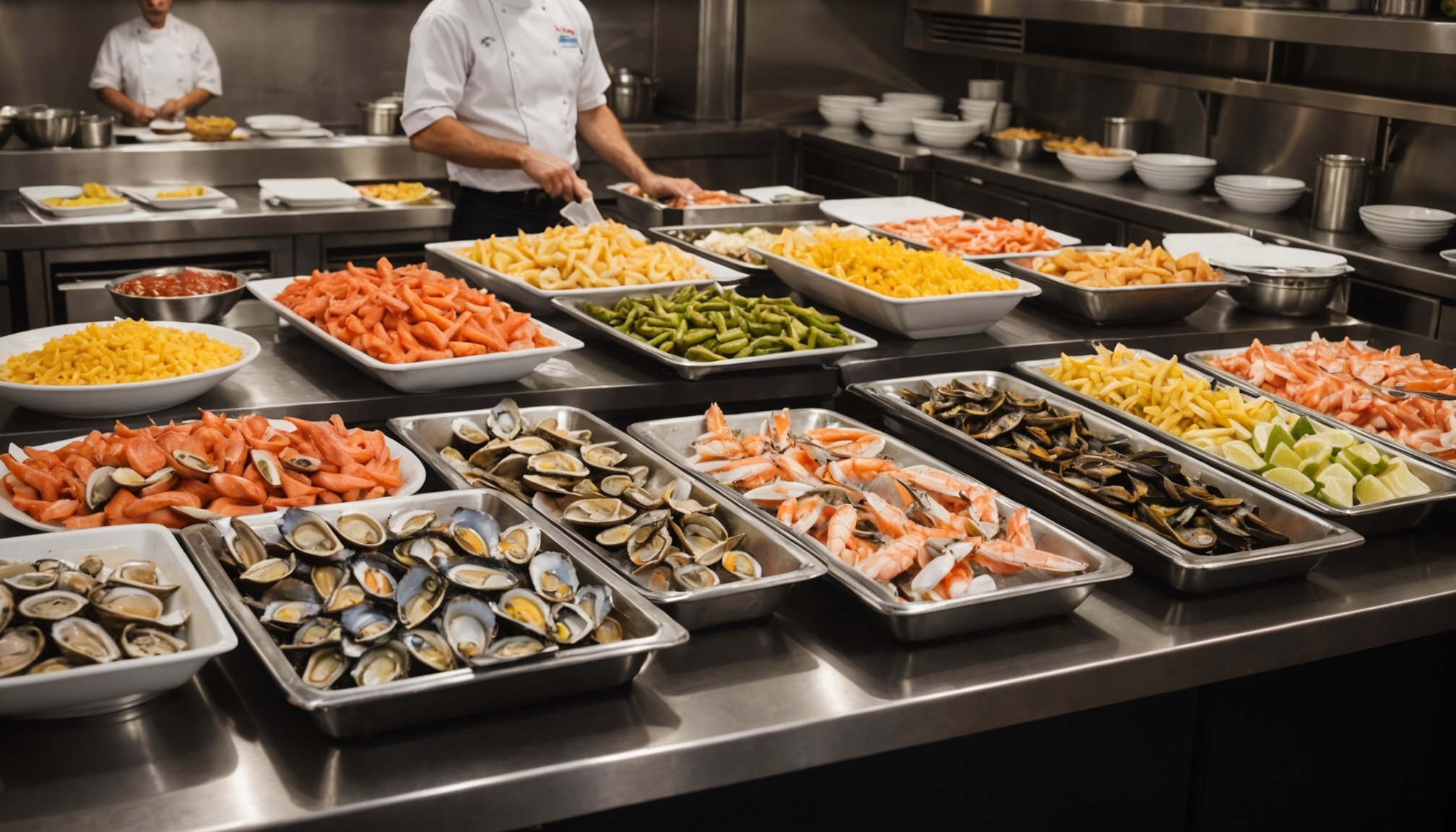Freshness is the lifeblood of any raw bar, directly impacting customer satisfaction and repeat business. Achieving maximum freshness requires more than just sourcing high-quality seafood; it involves understanding storage techniques, supplier relationships, and presentation methods. This guide reveals essential strategies to elevate your restaurant's raw bar, ensuring that every oyster, shrimp, and scallop served meets the highest standards. Discover how to enhance both flavor and quality, attracting a clientele that values freshness above all.
Sourcing Fresh Seafood
Understanding the nuances of seafood sourcing is essential for ensuring quality and freshness. Reputable suppliers are the cornerstone of this process, guaranteeing that the seafood you purchase is both safe and of high quality. This is where local fish markets shine, offering a direct line to the source.
Also to discover : Dynamic strategies for rapidly onboarding restaurant staff with new menu offerings in a high-energy setting
Local fish markets are not just about convenience; they often prioritize sustainable options, ensuring that the seafood is harvested responsibly. This commitment to sustainability benefits the environment and helps maintain the delicate balance of marine ecosystems. Moreover, buying locally means that the seafood has traveled a shorter distance, preserving its freshness.
Seasonal Availability
Understanding the impact of seasons on seafood availability is crucial for maintaining quality.
In the same genre : Crucial tactics for protecting food allergies in a high-energy restaurant kitchen
- Spring: Fresh salmon, halibut
- Summer: Tuna, mackerel
- Autumn: Lobster, scallops
- Winter: Cod, oysters
Seasonal availability directly affects the freshness of seafood. For instance, certain fish are at their peak quality during specific times of the year. By aligning purchases with these natural cycles, consumers can enjoy seafood at its best. This awareness also supports local economies and encourages more sustainable fishing practices. With a little knowledge and the right sourcing strategy, you can enjoy fresh, high-quality seafood year-round.
Proper Storage Techniques
Ensuring seafood freshness through optimal storage methods.
Temperature Control
Maintaining the right temperature control is crucial for preserving the quality of seafood. Different types of seafood require specific storage temperatures to remain fresh. For instance, fish should be stored at a temperature just above freezing, ideally between 32°F and 39°F. Shellfish, on the other hand, benefit from slightly cooler conditions, around 30°F to 34°F. Ensuring these temperatures are consistently maintained can significantly extend the shelf life of your seafood.
Ice Management
Effective ice management is another key factor in keeping seafood fresh. Ice should be clean, odorless, and used generously to cover the seafood completely. This practice not only helps maintain the desired temperature but also provides a moist environment, crucial for preventing dehydration. Regularly replenishing the ice ensures that the seafood remains chilled and fresh for longer periods.
FIFO (First In, First Out)
Implementing the FIFO (First In, First Out) method is essential for managing seafood inventory. This approach ensures that older stock is used before newer arrivals, reducing waste and ensuring that all seafood is consumed while still fresh. By integrating FIFO with proper temperature control and ice management, you can maintain a high standard of seafood quality and safety.
Presentation and Serving Strategies
Enhancing the dining experience with creativity and precision.
Creative Presentation Techniques
In the realm of seafood dining, raw bar presentation plays a pivotal role in capturing customer interest. Using vibrant garnishes and arranging seafood symmetrically can elevate the visual appeal. For instance, a seafood platter featuring oysters, shrimp, and crab claws can be artfully arranged on a bed of crushed ice, accented with lemon wedges and parsley. This not only highlights the freshness but also entices the customer visually.
Serving Suggestions
To emphasize quality, serving techniques should focus on simplicity and elegance. Consider offering seafood with minimal seasoning to allow the natural flavors to shine. Pairing with simple sauces, like a classic mignonette or a light citrus vinaigrette, can enhance the freshness without overpowering the dish. Such thoughtful serving suggestions ensure that the seafood remains the star of the plate.
Importance of Cleanliness
Maintaining hygiene is paramount in seafood presentation. Clean surfaces, utensils, and serving dishes are essential to ensure safety and enhance customer appeal. Regular sanitization and adherence to food safety standards not only preserve the quality but also build trust with diners. A clean presentation reflects a commitment to excellence and enhances the overall dining experience.
Quality Control Measures
Essential practices for maintaining seafood excellence.
Key Indicators of Freshness
Identifying freshness indicators is crucial in ensuring the quality of seafood. Look for clear, bulging eyes, bright red gills, and firm flesh. A fresh fish should have a mild sea scent, not a strong fishy odor. Shellfish, like oysters and clams, should have tightly closed shells or close when tapped. These indicators are vital for maintaining high standards.
Regular Inspection Processes
Regular inspection processes are integral to quality control. This involves routine checks at every stage, from delivery to storage. Inspectors should assess the condition of seafood upon arrival, ensuring it meets freshness criteria. The use of standardized checklists can help streamline these processes, ensuring consistency and reliability in quality assessments.
Importance of Staff Training
Staff training is essential for effective quality assurance. Employees should be well-versed in identifying freshness indicators and conducting inspection processes. Regular training sessions can enhance their skills, ensuring they are equipped to uphold the highest quality standards. This not only improves efficiency but also builds confidence in maintaining the seafood's integrity.
- Key Indicators: Eyes, gills, scent
- Inspection Steps: Delivery, storage checks
- Training Focus: Indicators, processes
By emphasizing these aspects, businesses can ensure their seafood offerings are consistently fresh and safe for consumption.
Industry Best Practices
Exploring strategies for maintaining seafood freshness in raw bars.
Successful Raw Bars
Successful raw bars have mastered the art of maintaining maximum freshness. For instance, renowned establishments like The Oyster House utilize advanced refrigeration systems and daily deliveries to ensure their seafood is as fresh as possible. Their strategy includes a FIFO system and meticulous temperature control. By prioritizing these practices, they consistently offer top-quality seafood.
Expert Insights
Industry experts emphasize the importance of sustainability in achieving freshness. Chef Emma Taylor, a leading voice in seafood cuisine, notes, "Sourcing from sustainable fisheries not only supports the environment but also ensures the best quality seafood." Her approach includes forming strong relationships with local suppliers to guarantee fresh, responsibly sourced seafood.
Trends in Freshness and Sustainability
The raw bar industry is increasingly focusing on trends that balance freshness with sustainability. Many establishments are adopting eco-friendly practices, such as using biodegradable packaging and supporting sustainable fishing methods. These trends are not only environmentally beneficial but also enhance the freshness and appeal of their offerings.
- Key Practices: FIFO, temperature control
- Expert Quote: "Sourcing sustainably ensures quality."
- Trends: Biodegradable packaging, eco-friendly methods
By integrating these strategies, raw bars can maintain maximum freshness while supporting sustainable practices, ensuring a superior dining experience.
Visual Aids and Checklists
Effective tools for enhancing raw bar operations.
Importance of Visual Aids for Staff Training
Utilizing visual aids is essential in the raw bar setup process, enhancing staff training and operational efficiency. Infographics serve as powerful tools, transforming complex procedures into easily digestible visuals. They can illustrate best practices for sourcing, storage, and presentation, ensuring that all staff understand and adhere to these standards.
Sample Checklists for Sourcing, Storage, and Presentation
Operational checklists are invaluable in maintaining consistency and quality in a raw bar setup. These checklists can cover various aspects, from sourcing to presentation, ensuring no step is overlooked. For instance:
- Sourcing Checklist:
- Verify supplier credentials
- Inspect seafood upon delivery
- Storage Checklist:
- Monitor temperature settings
- Implement FIFO procedures
- Presentation Checklist:
- Arrange seafood symmetrically
- Use fresh garnishes
Use of Infographics to Summarize Best Practices
Infographics can summarize key practices in a visually engaging manner, making them accessible for all staff levels. By incorporating visual elements, these tools can highlight critical steps in raw bar setup, from maintaining hygiene to ensuring freshness. As Chef Emma Taylor emphasizes, "Clear visuals ensure that everyone is on the same page, enhancing both efficiency and quality." This approach not only aids in training but also reinforces the commitment to excellence in seafood handling.













